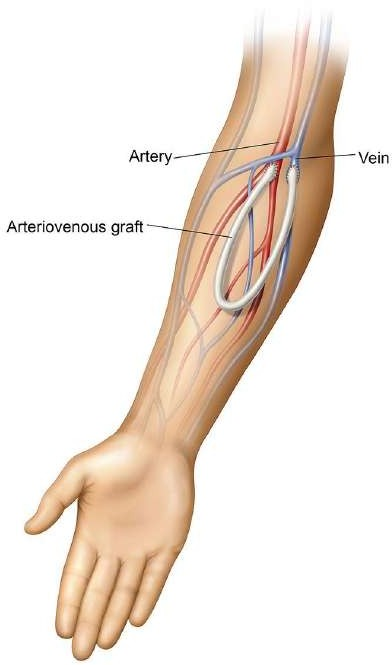A nurse is caring for a client who has a new arteriovenous (AV) graft in his left forearm. Which of the following techniques should the nurse use to assess the patency of this graft?
Measure the client's blood pressure to ensure it is higher in the left arm than the right.
Check the brachial and radial pulses of the left arm simultaneously.
Auscultate the antecubital fossa using a Doppler stethoscope.
Auscultate the site for a bruit.
The Correct Answer is D
Choice A reason: Measuring blood pressure di?erences is not a method to assess the patency of an AV graft.
Choice B reason: Checking pulses is important but does not confirm the patency of the AV graft.
Choice C reason: Using a Doppler stethoscope at the antecubital fossa is not the standard method for assessing AV graft patency.
Choice D reason: Auscultating for a bruit at the site of the AV graft is a common and non-invasive way to assess for patency.

Nursing Test Bank
Naxlex Comprehensive Predictor Exams
Related Questions
Correct Answer is B
Explanation
Choice A reason: While kidney infections can cause swelling, they typically do not lead to a significant increase in abdominal girth unless associated with severe obstruction or advanced kidney disease.
Choice B reason: In PKD, the kidneys can become significantly enlarged due to the growth of numerous cysts, which
can indeed lead to an increase in abdominal girth.
Choice C reason: While stones can cause blockage and swelling, they would not typically result in a generalized increase in abdominal girth unless there is an associated infection or severe obstruction.
Choice D reason: Inflammation can lead to fluid retention, but in the context of PKD, it is the cysts' growth that primarily contributes to increased kidney size and abdominal girth.
Correct Answer is A
Explanation
The correct answer is Choice A
Choice A rationale: Headache and restlessness can be signs of a seizure or neurological disturbance, which phenytoin is used to treat. Phenytoin is an anticonvulsant medication that helps control seizures by stabilizing neuronal membranes and reducing excitability.
Choice B rationale: Decreased blood pressure and rapid pulse are not indications for phenytoin administration. These symptoms may suggest hypotension or cardiovascular issues, which require different interventions such as fluid resuscitation or vasopressors.
Choice C rationale: Muscle cramps and chest heaviness are not treated with phenytoin. These symptoms could indicate electrolyte imbalances or cardiac issues, which need specific treatments like electrolyte replacement or cardiac monitoring.
Choice D rationale: Pain and tingling at the access site are not indications for phenytoin administration. These symptoms may suggest local irritation or infection at the dialysis access site, requiring appropriate wound care or antibiotics.
Whether you are a student looking to ace your exams or a practicing nurse seeking to enhance your expertise , our nursing education contents will empower you with the confidence and competence to make a difference in the lives of patients and become a respected leader in the healthcare field.
Visit Naxlex, invest in your future and unlock endless possibilities with our unparalleled nursing education contents today
Report Wrong Answer on the Current Question
Do you disagree with the answer? If yes, what is your expected answer? Explain.
Kindly be descriptive with the issue you are facing.
